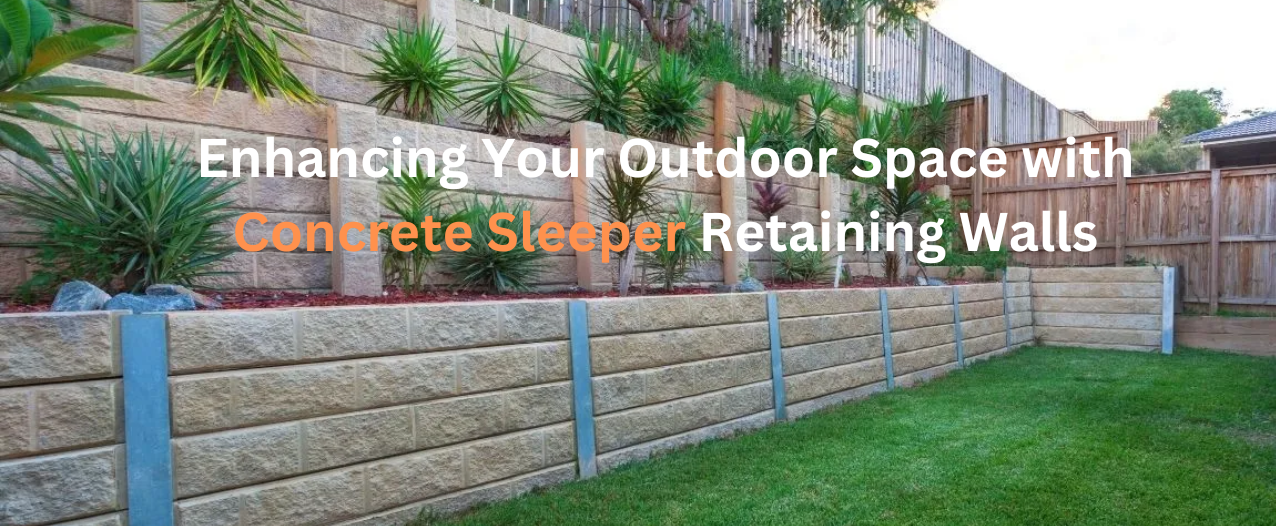Have you ever imagined creating an exquisite outdoor haven in your backyard? I’m here to assure you, though, that it is very possible! An excellent option to give your outdoor space structure, elegance, and utility is using concrete sleeper retaining walls. Now let’s explore this fascinating and robust universe of building components.
A concrete sleeper wall can be the finest choice for you if you’re searching for a long-lasting and attractive addition to your area. It also stands out by giving your yard a visually pleasing appearance and is essential in preventing soil erosion.
We’ll go over what concrete sleeper retaining walls are in this tutorial, as well as how they might improve your outdoor area. Without further ado, let’s dig right into this guide.
What Are Concrete Sleeper Retaining Walls?
Particularly in areas with varied terrain, concrete sleeper retaining walls are robust structural barriers that stop soil erosion and keep soil in place. Furthermore, because of their strength and longevity, these wood-based retaining walls are becoming more and more well-liked. Additionally, these concrete sleepers often exhibit greater long-term resistance against the elements as compared to lumber.
In addition to concrete sleeper retaining walls, sandstone floor tiles and sandstone steps provide a natural aesthetic, perfect for complementing outdoor spaces. These materials enhance the overall design while ensuring durability and slip resistance, especially in high-traffic areas like gardens and driveways.
In addition, there is a flexible choice for both commercial and residential applications because of their superb texture and finishing. Concrete sleeper retaining walls come in a variety of styles to fit your needs, from sleek to contemporary.
Also Read – Why is Garden Edge Concrete a Durable and Versatile Choice?
What Advantages Do Concrete Sleeper Retaining Walls Offer?
Let’s now talk about a few advantages of concrete sleeper retaining walls. These are as follows:
Superb Sturdiness
The extraordinary durability of concrete sleepers is one of its main benefits. Concrete sleepers are made to last, in contrast to stone or wood walls that may shift or decay over time. They are resistant to breaking or degrading in the face of severe weather, wetness, and high temperatures. They are thus perfect for places that frequently experience frigid temperatures, harsh sun, or heavy rain.
Minimal Upkeep
Regular maintenance is not a concern when using concrete sleeper retaining walls. There’s no need for painting, staining, or sealing, as you might anticipate with wood or metal. After installation, these walls can withstand the elements with little maintenance, thus saving you money and effort.
Flexibility in Aesthetics
For design freedom, concrete sleepers provide the most options. Whether you want a more traditional style that resembles real stone or wood, or a sleek, modern appearance, concrete sleepers may be made to your exact requirements. To match the general style of your outdoor area, they might be patterned, colored, or textured.
Environmentally Sustainable Choice
Concrete sleepers are an eco-friendly choice as they often employ recycled materials. You may help protect forests and other natural resources by switching to concrete instead of wood.
An increase in real estate values
Your home’s value might be raised with a thoughtfully designed concrete sleeper retaining wall. They enhance your property’s curb appeal and functionality without sacrificing its structural soundness. Potential purchasers will likely value the long-term benefits and visual appeal of a well-constructed retaining wall.
Adaptable Uses
You may use concrete sleeper retaining walls for more than simply flower beds. They are useful for many different landscaping tasks, such as:
- Building terraces or gardens with many levels
- assisting pathways and driveways
- defining outdoor areas for living
- constructing elevated flower beds
- provide structural support in regions with slopes or hills
Also Read – The Role of Sandstone Ballast in Modern Landscaping Projects
Installation Tips For Concrete Sleeper Retaining Walls
- Plan and Measure: To begin, measure the area that will be used for the retaining wall. Next, carefully plan the wall’s height and design.
- Excavate a Level Trench: How to dig a level trench to fit the first row of sleepers while also providing appropriate drainage, dig a deep trench at the base of your wall.
- Create a Strong Foundation: Before you install your first row of concrete sleepers, lay a foundation layer of crushed stone or gravel for stability and drainage.
- Put in Drainage Pipes: Installing perforated pipes beneath the wall will ensure appropriate drainage and minimize water accumulation, which can lead to instability.
- Verify Stability: To keep the wall stable as you construct, ensure that each row is level and positioned correctly.
- Finish with Capping: Add concrete sleeper capping to complete the appearance and provide further protection against weathering and erosion.
Wrapping Up!
The several advantages of using concrete sleeper retaining walls to improve your outdoor area have been covered in this essay, including their remarkable longevity, ease of upkeep, flexibility, and visual versatility. Concrete sleeper retaining walls are an excellent option whether you’re looking to create a contemporary landscape or stop soil erosion.
Maroota Sandstone Quarry has all the information we’ve covered here, including installation instructions and design concepts. If you’re searching for professional advice and premium materials that will guarantee the longevity and success of your retaining wall project, we are your best choice. Come see us for any outdoor-related requirements you may have!
FAQ’s
Q1. How to make a retaining wall on a slope?
Answer: When building a retaining wall on a slope, begin by excavating a level trench at the slope’s base. Then, as the slope increases, step the wall upward. Make sure enough drainage is set up to avoid the accumulation of water behind the wall, which might lead to instability.
Q2. Do I need council approval to replace a retaining wall?
Answer: Replacing a retaining wall typically requires municipal approval, particularly if it obstructs drainage or is higher than permitted. Before starting any construction project, it is critical to double-check the local guidelines.
Q3. How to build a railway sleeper retaining wall?
Answer: The railway sleeper retaining wall is formed by stacking the sleepers horizontally in a ditch and fastening them with steel rods or spikes. Make sure there is enough drainage to prevent erosion and water pressure buildup behind the wall.
Q4. How to fix the retaining wall washout?
Answer: Installing gravel and perforated drainage pipes behind the wall is the first step toward fixing a washout in a retaining wall. This will solve the drainage issue. Rebuild the damaged area with enough reinforcement and compacted backfill to prevent more washouts.
Q5. Who is responsible for a retaining wall between properties?
Answer: In most cases, the owner whose land benefits from a retaining wall between properties is responsible for maintaining it. It’s crucial to review legal rules since local property laws and boundary agreements may have an impact on this.




